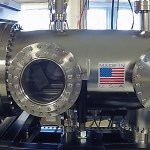x-rays
Ever imagined that an Xbox controller could help open a window into the nanoworld of groundbreaking physics? Well, check out the video above.
Brookhaven scientist Ray Conley designed that one-of-a-kind machine to grow (through a technique called sputtering deposition) atomically precise lenses that can focus x-rays to within one billionth of one meter, revealing the internal nanoscale structure of materials such as electric vehicle fuel cells.
When tweaking his recipe for these multilayer Laue lenses (MLL), Conley used to have to manually enter commands into a computer to move a crucial…
"A colour is a physical object as soon as we consider its dependence, for instance, upon its luminous source, upon other colours, upon temperatures, upon spaces, and so forth." -Ernst Mach
Our Sun, like all Sun-like stars, will come to the end of its life someday. All the hydrogen fuel in its core will eventually burn up, and when this happens, the core itself will begin to contract. When temperatures are finally high enough, the end product of hydrogen fusion -- Helium-4 -- will begin to fuse in the contracted core, and the Sun will expand into a Red Giant.
Image credit: Northwestern…
Building 3D images gets trickier with objects bilions of times smaller. (courtesy Electric-Eye on Flickr)
Let's start with a number, by chance a palindrome: 1441. Imagine taking that many photographs of a single object, a soccer ball, say - obsessively capturing it from every angle to expose all the details. Those 1441 images provide all the evidence needed to illustrate and understand the three dimensional structure of that soccer ball. Each shot reveals another curve of the sphere, another line in the checkered pattern, another scuff or scratch along the surface.
An adept programmer or…
The second in the DAMOP research categories I talked about is "Extreme Lasers," a name I was somewhat hesitant to use, as every time I see "Extreme [noun]," I get a flash of Stephen Colbert doing air guitar. It is, however, the appropriate term, because these laser systems push the limits of what's possible both in terms of the pulse duration (attosecond pulses are common, with 1as = 0.000000000000000001 s) and the pulse intensity (1014 W/cm2 is a typical order-of-magnitude, and some systems get much higher than that).
One of the main tricks for generating these ultra-short pulses is to do…
Hair breaks. It singes. It falls out. It might not be the strongest feature of living human bodies, but hair is one of the best-preserved tissues of dead ones, providing a record of diet, age, metabolism, and, sometimes, even the cause of death.
Ferdinand II*
With intense beams of x-rays at Brookhaven's National Synchrotron Light Source (NSLS), a team of researchers is using hair samples collected from the decomposed bodies of two 15th century Italian royalty to determine how they really died.
The subjects: Ferdinand II (1467-1496)* and Isabella (1470-1524) of Aragon, a medieval kingdom…
This has been all over my inbox since the press release came out yesterday; it's been on slashdot (thanks Brian), it's been at space.com, and there's a mediocre writeup on Universe Today. What's the big news? Black Holes don't destroy information after all!
What is this whole information thing, anyway? Take a look at all the normal stuff in the Universe: photons, protons, neutrons, and electrons, for example. They have lots of different properties each. They move around one another, they get bound and unbound from one another, they exert forces on one another, etc. They're aware of one…



